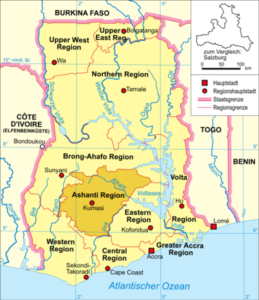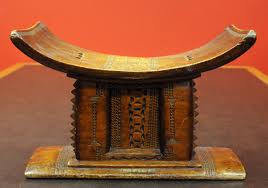Ghana
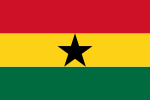 This country in West Africa used to be known as “The Gold Coast”, because a great deal of gold was found in the ground and rivers. It was because of this gold that the medieval kingdom of Old Ghana was built.
This country in West Africa used to be known as “The Gold Coast”, because a great deal of gold was found in the ground and rivers. It was because of this gold that the medieval kingdom of Old Ghana was built.
Location and Landscapes
Ghana lies on the Atlantic Ocean. In the west it is bordered by the Ivory Coast and in the east by Togo and Benin. The white, black and red Volta rivers begin in the highlands of Burkina Faso and they join the Volta Lake in Ghana. The Volta Lake is the biggest artificial lake in the world. Ghana is also home to one of the most mysterious lakes in the world: The Bosumtwisee. It was created when a meteor struck and therefore has no source – no inlet or outlet. Because of that the people have given the lake a special religious association.
Ghana is a tropical country. In many areas there are still tropical rainforests. Ghana doesn’t have four seasons as we do, but changes between a rain season and a dry season.
Ghana is almost as big as Great Britain, which ruled over Ghana in colonial times.
Accra, the Capital of Ghana
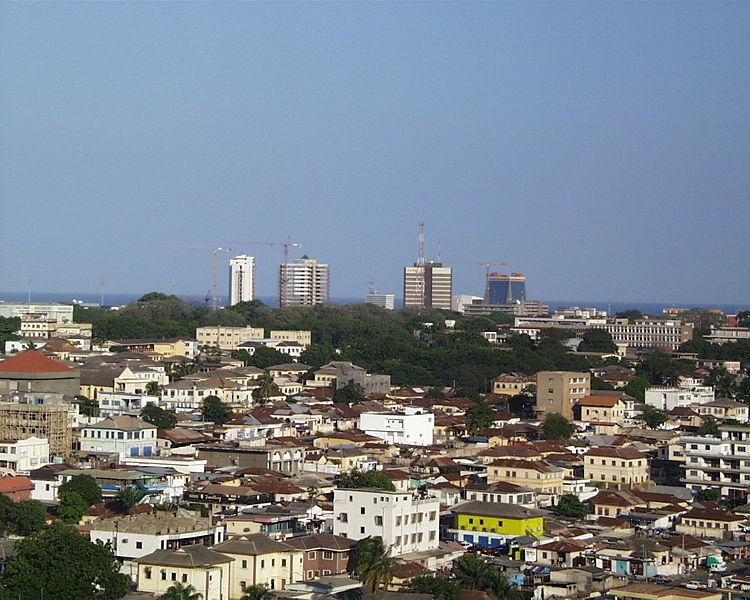
(c) ElegantMachines
Ghana’s capital Accra is located at the Atlantic ocean. It was founded by the Ga people during the 15th century. At that time the first Portuguese traders came to Ghana, who wanted gold, ivory and slaves. The Ga were merchandisers who dealed with the Portuguese traders. Today Accra is a modern city with more than 2 million inhabitants. Ghana’s government and administration is concentrated in Accra. The town is also a centre for manufacturing, marketing, finance, insurance, and transportation. The National Theater was built in the 1990 to raise the performing arts. The modern designed theater has helped to showcase the talents of young actors, musicians and dance companies. Near by Accra there is the Kotoka International Airport. Tourists come to Accra to visit the Makola Market where they find all types of delicacies and traditional foodstuff of the Ghanaians. Some enjoy beach life and sports. The city is surrounded by growing slums, actually there are nine.
Agbogbloshie, Africa’s biggest Scrapyard
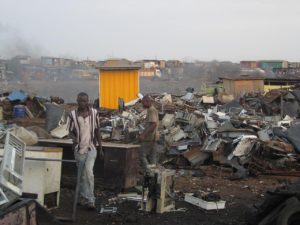
(c) Marlenenapoli CC0
Agbogbloshie is a suburb of Accra, it is known as a “digital dumping ground” of electronic waste from industrialized nations. 40 000 Ghanaians inhabit the area and live of sorting out materials and electronic parts that can be reused. The waste discarded in 2015 contained around 300 tonnes of gold, 16 million tonnes of iron and nearly two million tonnes of copper as well as significant amounts of silver, aluminium and palladium. And alarmingly, it also contained toxic material like mercury and cadmium. The area is heavily polluted and there are concerns over methods of waste processing – especially burning – which emit toxic chemicals into the air, land and water. Exposure is especially hazardous to children, as these toxins are known to inhibit the development of the reproductive system, the nervous system, and especially the brain. Due to its harsh living conditions and rampant crime, the area is nicknamed “Sodom and Gomorrah”.
Economy and Natural Resources
 Ghana is a country rich in natural resources and gold. The export of cocoa and fine wood is however of bigger economic importance.The country is the second largest producer of cocoa beans in the world. This means, half of the chocolate you consume, is made by cocoa beans from Ghana. Other agricultural exports include sugar, cashew and shea nuts, palm oil, cocoa butter and rubber. However, small-scale farmers who grow the cocoa can struggle to make enough money to invest in planting new trees and protect them against diseases. Agriculture employs over half the population. Once Ghana was called “the Gold Coast”. Gold mining in Ghana is dating back to the 15th century. To this day, the country remains Africa’s second largest producer of the metal. Much of the gold wealth goes to the foreign mining companies. Other mineral resources mined in Ghana include diamonds, manganese and bauxite. Since oil reserves were found off the coast in 2007, Ghana expects an important boost to the economy. The electricity sector of Ghana is very diverse and effective: there are wind parks, hydropower and solar energy produced besides the gas and oil industry.
Ghana is a country rich in natural resources and gold. The export of cocoa and fine wood is however of bigger economic importance.The country is the second largest producer of cocoa beans in the world. This means, half of the chocolate you consume, is made by cocoa beans from Ghana. Other agricultural exports include sugar, cashew and shea nuts, palm oil, cocoa butter and rubber. However, small-scale farmers who grow the cocoa can struggle to make enough money to invest in planting new trees and protect them against diseases. Agriculture employs over half the population. Once Ghana was called “the Gold Coast”. Gold mining in Ghana is dating back to the 15th century. To this day, the country remains Africa’s second largest producer of the metal. Much of the gold wealth goes to the foreign mining companies. Other mineral resources mined in Ghana include diamonds, manganese and bauxite. Since oil reserves were found off the coast in 2007, Ghana expects an important boost to the economy. The electricity sector of Ghana is very diverse and effective: there are wind parks, hydropower and solar energy produced besides the gas and oil industry.
Plants and Animals
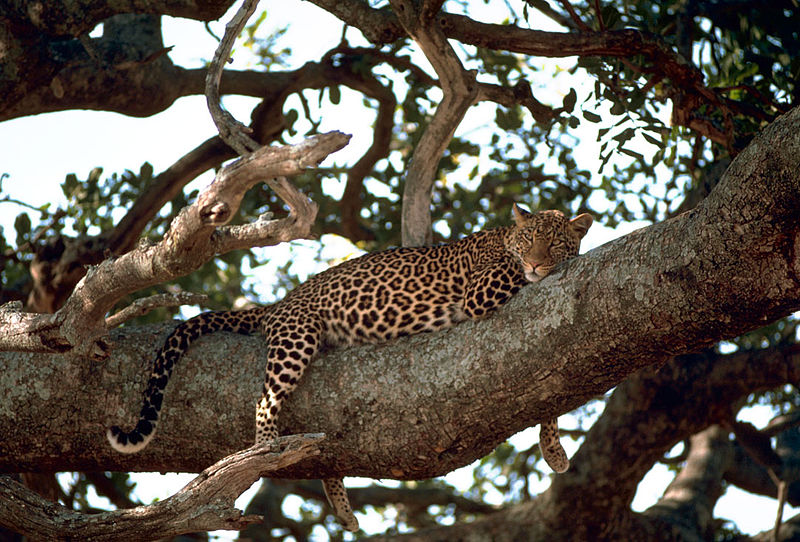
(c) Billede
Have you ever drunk the milk of a water buffalo? Water buffalo are kept as domestic animals in northern Ghana. Water buffalo are hurd animals and have already been domesticated for centuries. Their skin is made into leather and their milk sold and drunk.
In the Savannas in the north, there are monkeys, hippos, rhinoceros and elephants. Common hoofed animals such as the lowland bongos (a type of antelope) and giraffes are hunted by predators like hyenas, leopards and lions. In the rainforests there is a variety of snakes, geckos, turtles and insects. In Ghana there are also many stories and fables about spiders.
Festivals and Celebrations
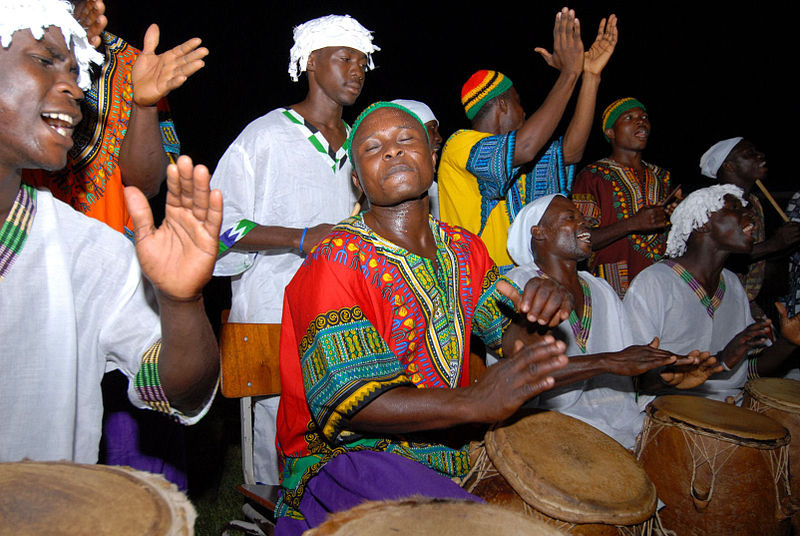
(c) Elilio Labr
In Ghana people enjoy dancing and celebrating. Dancing expresses zest for life and preserves the many traditions and rich history of the people. They celebrate everything from birth and death, victory or defeat, hunting, harvest or starvation. Guests are also welcome to join in the celebrations. There is something to celebrate on almost every day in Ghana.
As well as Easter, Christmas and Independence Day on the 6th March, many traditional events are also celebrated, the dates of which are sometimes only set a few days in advance.
Drumming is an important part of the celebrations. Drummers and drum makers have a great reputation. For the creation of drums, rose wood or mahogany is hollowed out and covered with goat hide.
When you think of Ghana’s past of Slave Trade and colonisation, it adds a sad element to the now bright and cheerful Ghana.
There is also a wise Ghana, concerned with protecting tradition and the experience of the older members of the community. People in Ghana have a strong feeling of community spirit.
Funerals and the Ghanaian Coffin Artists

(c) Jean Michel Rousset
Paa Joe is Ghana’s most prolific coffin artist and, after five decades in the funeral industry producing some of the world’s most extravagant designs, his work is being celebrated in a major exhibition in Accra. Joe’s work – which includes coffins in the shape of Porsches, naked women, Nike trainers, cameras, Coca-Cola bottles, fish and chilli peppers – is designed to represent the life of the deceased. Each fantasy coffin is handcrafted and painted for the funeral procession, which can last up to three days and three nights. The local price for a coffin for conventional use is equivalent to about EURO 2,000, depending on the commission. Those created for exhibitions can fetch up to EURO 12,000.
Joe discovered coffin-making when he was 16, when his mother sent him to do an apprenticeship in the Ga fishing community of Teshie. His uncles were prominent fantasy coffin makers in the area in the 1950s, and Joe worked with them for 12 years before returning to Accra in 1976 to establish his own workshop. His first fantasy coffin, carved in 1978, was in the shape of a building and designed for a real-estate developer. The coffins underline the idea of art being part of life and death in Ghana. Joe’s coffins have been prevalent in the birth of contemporary African art in the west.
History of Ghana
Ghana – and its Medieval Kingdom
The cultural diversity of Ghana comes from the different peoples, such as those from Ashanti, who still practise very old traditions. In the middle ages, one of the biggest African kingdoms was established and called Old Ghana. The Republic of Ghana is named after the medieval Ghana Empire of West Africa. The actual name of the old Empire was Wagadugu. Ghana was the title of the kings who ruled the kingdom. In 1240 AD, it was controlled by Sundiata, the lion king and absorbed into the larger Mali Empire. The Portuguese who came to Ghana in the 15th Century found so much gold that they called the region Gold Coast. The longstanding traditions and cultural aspects of Ghana and its different people, helped to cultivate the region of Ashanti.
The Ashanti and the Slave Trade
From the 18th century on the Ashanti controlled an extensive part of the Gold Coast. By this time the British, Dutch and Danes are the main European traders on this part of the coast, and the most valuable commodity for export is not gold but slaves. Trading slaves for muskets, among other western commodities, the Ashanti acquire great local power. Their king, the Asantehene, enthroned on a traditional golden stool, holds sway over the entire central region of modern Ghana. But the Ashanti suffer a series of major blows between 1804 and 1814, when the Danes, British and Dutch each in turn outlaw the slave trade.
Ghana and the Golden Chair
In Ghana chairs have a very special meaning. Everybody has their own favourite chair and nobody would give their chair away. Sons receive a chair from their fathers as their first present. Brides get given a chair on their wedding day. When somebody dies, they are sat on their chairs until they are buried. Afterwards, the chair is put into a room where it can be honoured.
The legend of the Golden Chair is very famous in Ghana. The legend goes, that a golden chair fell from the skies and that it was so holy that not even the Kings of Ashanti could sit on it.
Ghana’s Colonization
In the coastal regions of Ghana the British are gradually emerging as the main European power. In 1874 the southern regions are formally proclaimed a British colony, under the name Gold Coast. Three decades later the Ashanti kingdom is brought under British control. In 1901, Ashanti is declared a British crown colony. The regions further north become at the same time the Protectorate of the Northern Territories of the Gold Coast. The colonial years are relatively prosperous and untroubled. At first little is done to involve the African population in the political processes of the colony. But in the years immediately after World War II the Gold Coast becomes the first colony in sub-Saharan Africa to win its independence.
Ghana’s Independence
The founding father of the Ghana nation was Kwame Nkruma. From January 1950 he organized a campaign of nonviolent protests and strikes, to become independent from the british power. In 1952 Nkruma became prime minister. Under Nkrumah’s leadership the Gold Coast became independent in 1957. A new name of great resonance in African history was adopted – Ghana, the medieval kingdom north of what is now Ghana. Nkruma led the country to a peaceful reconciliation from its colonialists. He went past oppression to deliver his nation in a peaceful land.
Ghana Today
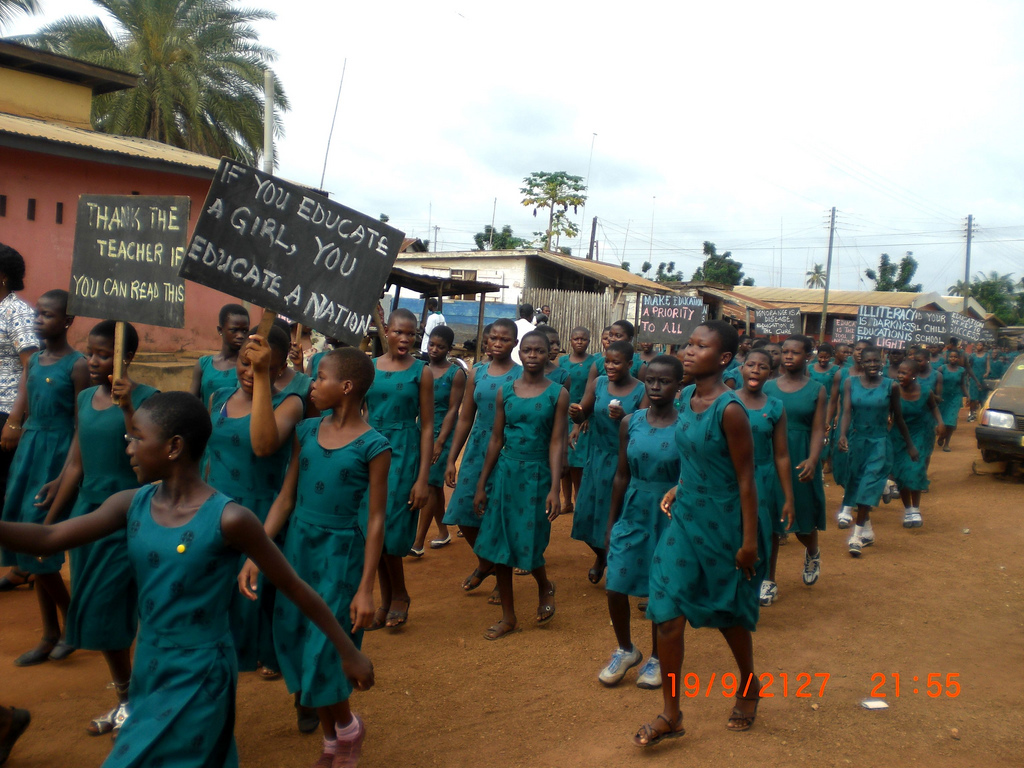
(c) C.hugues
Formerly known as the Gold Coast, Ghana gained independence from Britain in 1957. It was the first sub-Saharan nation to break free from colonial rule. Since its transition to multi-party democracy in 1992, Ghana is considered one of the more stable countries in West Africa. Ghana’s economy is based on gold, cocoa and more recently oil which helped fuel an economic boom. Until recently Ghana was hailed as a model for African growth but since 2013, its economy has endured a growing public deficit, high inflation, and a weakening currency.
What do young Ghanaian think about their country and their future?
“We’re sick and tired with the lights on and off. And water…for my place the water’s off for like three months before they bring it back. So we are sick and tired of those things. In Accra, it’s easy for some to move forward. Those who have the money, water and lights on in their house, they don’t care about the others struggling.” says Abass Ismail, Ghanaian cinematographer.
“My Accra is a place where everything is possible. Accra is a place where young, vibrant people from all over Ghana come to settle and achieve their dreams. It’s also challenging. Despite the challenges, it’s a place where you can succeed if you are really determined.” says Dean Osei, a young photographer from Accra
Ghanaian Literature
Ghanaian literature is traditionally based on oral literature as most histories and stories were passed on by spoken word through song, poetry and folktales. Most of these stories are still accessible, and contemporary Ghanaian writers have found ingénue ways to channel new and traditional ways of telling stories into their books. Some of the writers you should pay attention to when it comes to Ghanaian literature are Ayi Kwei Armah and Ama Ata Aidoo. Ayi Kwei Armah is probably the most distinguished African writer in terms of stylistics. In his debut novel, The Beautyful Ones Are Not Yet Born, he employs language creatively to build elaborate detail about post-colonial Ghanaian society. He provides brave and well-thought-out criticism of his society, which requires the reader to react. From a young age, Ama Ata Aidoo has demonstrated the ability to write expertly with poetry, prose and drama. She seamlessly switches between these genres to whichever she feels would allow her to express her ideas best. Her primary focus are women’s issues and gender as she uses her work to bring to light the matters that affect contemporary Ghanaian women. Her award-winning novel, Changes is a fierce piece of fiction that exposes people to the different facets of Ghanaian women.

